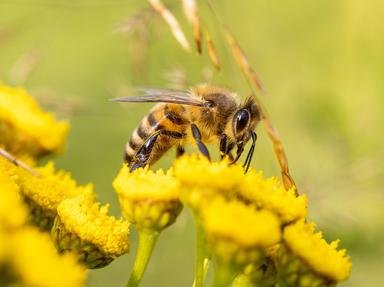Quiz Answer Key and Fun Facts
1. To which order of insects does the bee belong?
2. Bees and their ancestors have been around for millions of years. In October 2006 the scientific world was literally abuzz about the discovery of the oldest fossilised bee ever found. In which country and place was this exciting find made?
3. What is the name given to someone who studies or keeps bees?
4. The life cycle of the bee has four stages, of which the egg is the first. What is the name of the second stage?
5. What regal-sounding food is fed to the developing larvae and adult queen bees, is marketed as a dietary supplement, and can also be found as an ingredient in cosmetics?
6. What role do the drones play in the community of the beehive?
7. What is the name of the appendage the bee pushes into a flower in order to extract nectar?
8. What geometric shape are the cells of the honeycomb?
9. Apart from honey, what other useful product is created by bees? It has many uses including crafts such as candle-making, and can also be found as an ingredient in furniture polish, skincare and pharmaceutical products.
10. Active Manuka honey is claimed to have the best antibacterial properties of any honey and many other important health benefits. It is therefore one of the world's most sought-after types of honey, and the most expensive. Which country produces Manuka honey?
Source: Author
Jennifer5
This quiz was reviewed by FunTrivia editor
gtho4 before going online.
Any errors found in FunTrivia content are routinely corrected through our feedback system.

